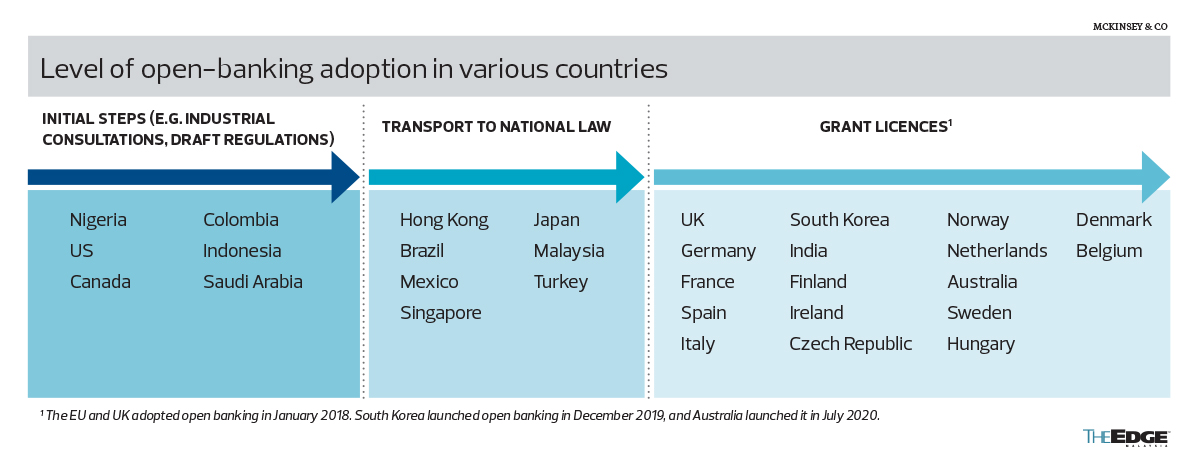
This article first appeared in The Edge Malaysia Weekly on August 9, 2021 - August 15, 2021
THE pace of adoption of open financial data — commonly known as “open banking” — varies in Asia, with Malaysia still at an early stage and South Korea and Singapore more advanced, according to McKinsey & Co.
Open banking is the practice of sharing customers’ banking data with third parties, electronically, under conditions that the customer approves of.
Banks have a treasure trove of information on what customers spend on, save or borrow — from bill and loan payments to shopping and coffee habits — and this is valuable data that third parties such as challenger banks and financial technology (fintech) firms can use to come up with suitable products and services for customers.
With open banking, customers can pull that data directly, with authentication, into another bank or fintech, says Raphael Bick, a partner at McKinsey’s Shanghai office in China.
“As a consumer, it makes it easier to apply for a loan, for example, at another financial institution (FI) because you can easily [share] your data and your transaction history with that new FI you’re planning to bank with. It will also make it easier for you to access products and services from a variety of banks,” he tells The Edge in an interview.
Having access to such data enables smaller banks or challenger banks to offer compelling propositions to customers. “To some extent, you can argue that customer lock-in will decrease and it creates a more competitive financial services system,” Bick says.
This global movement of sharing banking data with third parties is roughly half a decade in the making and, thus, still in its infancy.
McKinsey, in a July 11 report on the state of open banking around the world, notes that the trend is evolving in different ways around the world. The EU, the UK, South Korea, Australia and India have mandated large banks to open up their troves of customer accounts to other companies, in a bid to stimulate competition.
However, in the US and China, it is a market-led movement, with companies establishing open-banking relationships among themselves. Singapore uses a blend of the two models.
The details of exactly what customer information can be shared with third parties and for how long, among other things, play out differently in various countries.
“Open banking was originally driven out of the notion that customers own their own data, and so the customer could specifically decide what data to share [with third parties], and for how long to share it. And then, when it comes to local regulatory implementations, are things such as at what level of detail will data get shared,” Bick states.
The “models” of open banking in different countries are all just nuances of the same architecture, he explains. “In all of these cases, the request or approval [to allow the access of data to third parties] is always given by the customer. But then, dimensions where you can see differences are in what types of data, to what degree it is mandated what data you share versus it being left to the individual institution to define what data they are sharing and for what periods of time, and how easily this has to be linked or implemented within the digital channels.
“If you look at Singapore, for example, it relies a lot on banks to define some of the standards themselves. In the original implementation in the UK, some of the rules around durations and what can be shared were a lot more explicit,” he adds.
Singapore launched a common public-private infrastructure known as Singapore Financial Data Exchange, or SGFinDex, in December 2020 to enable aggregated open financial data for consumers. While it has no official banking regulation or licensing scheme in place there, it has published an application programming interface (API) playbook to encourage banks to open up their data, systems and services.
The EU and the UK adopted open banking in January 2018, while in Asia, South Korea launched it in December 2019.
‘More can be done’
In this country, it is up to Bank Negara Malaysia to set the standards.
“In Malaysia, some of the [enablers] for open banking are being put in place — for example, the national digital identity (ID) and e-signature, because without a digital authentication framework, it’s not particularly helpful to have open banking since, as a customer, I can’t uniquely authenticate myself,” Bick says.
However, in terms of actual adoption of digital banking, or there being specific regulations, Malaysia is still at an early stage.
“Relative to other markets in the region, I think more can probably be done to enable open banking in the next few years. There are various initiatives that the government is pushing, such as real-time payments that allow you to link into the e-KYC (know your customer), digital ID kind of features, and those will be helpful. But at the moment, I think for practical intents and purposes, open banking as you would understand it in the UK banking market, for example, does not exist yet in Malaysia,” he comments.
The UK, among the world’s most advanced in open banking and which outpaces EU countries in the growth of the open-banking ecosystem, had as at December 2020 issued 200 third-party provider licences for open-banking APIs — shortcuts that make it easier for software developers to build new applications, according to McKinsey.
Bick notes that in the UK, the impact of open financial data on the banking sector has not been as substantial as many incumbents had initially feared. “The reason for this is that many of the incumbents have also adapted well to the products and services that they’re offering, and also because banking relationships tend to be very sticky.”
Will open-banking developments pick up the pace in Malaysia considering that the central bank is expected to give out up to five digital banking licences next year?
“What Bank Negara has demonstrated is that it is clearly in favour of financial innovation and, at the same time, more customer protection and data privacy. If you look at, for example, the ongoing frameworks for digital attacker banks like virtual banking licences, its statements are quite clear around driving more access for financial services to the B40, creating more competition and innovation but at the same time ensuring the stability of the financial system. But I haven’t seen as much yet, specifically on the open-banking topic from Bank Negara,” he says.
In January 2019, the central bank published a policy document that recommended the standards of open APIs that banks in Malaysia should adopt. In its response to common feedback and queries from the public, Bank Negara stated that banks are encouraged to share certain banking information with third-party service providers through open APIs, but are not obliged to do so.
Bick opines that open-banking adoption will be driven as it plays out in other markets.
“A number of countries in the region are looking at it. Thailand has a version of it but it is also still early days. South Korea is furthest down the road and Singapore [has advanced], too. But it’s not yet as widely implemented in Asia as it is in Europe, where I think because of the GDPR (General Data Protection Regulation), open banking has picked up momentum a few years ahead of time.
“So, I would expect more movement on it in the future in Asia, but I think at this point, concrete announcements on what features will come out, what elements the frameworks will have, are still in the early days.”
Is it inevitable that countries must eventually adopt open banking? “I don’t think a country must adopt open banking per se. It is one of the tools that are available to foster financial innovation and it is a tool that is quite aligned with a general trend to give customers ownership of their data. So, from a country’s perspective, the way to think about it is, the more you want to enable financial innovation, particularly in attacker players’ new product/service category, open banking can help,” he says.
Save by subscribing to us for your print and/or digital copy.
P/S: The Edge is also available on Apple's App Store and Android's Google Play.


